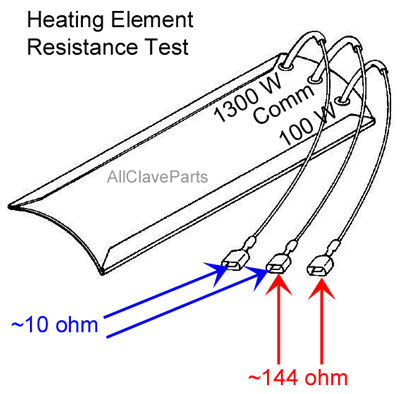How To Test The GLS10 Dual Heating Element
This test consists of measuring the amount of resistance in the element. To do this, first, turn the autoclave off and unplug it from the wall
WARNING: CURRENT MUST NOT BE PRESENT WHEN MEASURING RESISTANCE.
Set your volt/ohm meter on 200 ohms (200 NOT 200k). The ohms range is
located within the Omega (
Ω )(look for this symbol) section of your meter. It is also
the area with "k" ' ranges (ie: 2000k,. 200k, 20K and then 2000, 200).
The lowest setting on your meter is always the most accurate
This heating element has 3 wire leads and the spot where each wire lead orginates from is stamped on the heating element as follows:
- 1300W
- COMM
- 100W

As you unplug each lead from the board, make a note of where you removed it from to simplify reconnecting when you are finished with this test
Place a probe from your meter into the plug on the center wire, marked "COMM" and place the second probe from your meter into the plug marked 1300W
and write down the reading on your meter.
Now, place a probe into the center plug marked COMM and the other probe into the plug marked 100W and again record your readings
Simply compare your readings to those corresponding to those in the table below
For the heating elements to be good, they must fall within the resistance range in this table.
If your readings for either element are outside of the ranges below, then it is defective and the heating element needs to be replaced.
|
| Model |
Volts |
Watts |
Amps |
Resistance |
Resistance Range |
| MDT Ritter Castle GLS10 Dual Heating Element |
120v |
1350 Watts |
11.250 amps |
~10.0 Ohms |
9.00 ↔ 11.00 ohms |
| MDT Ritter Castle GLS10 Dual Heating Element |
120v |
100Watts |
00.833 amps |
~144 Ohms |
129.6 ↔ 158.4 ohms |